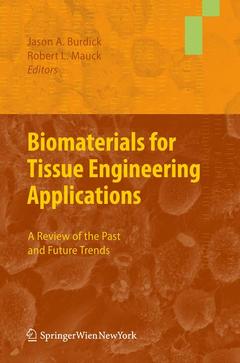Description
Biomaterials for Tissue Engineering Applications, 2011
A Review of the Past and Future Trends
Coordinators: Burdick Jason A., Mauck Robert L.
Language: English
Subjects for Biomaterials for Tissue Engineering Applications:
Publication date: 12-2014
564 p. · 15.5x23.5 cm · Paperback
Publication date: 12-2010
564 p. · 21x27.9 cm · Hardback
Description
/li>Contents
/li>Biography
/li>Comment
/li>
A concise overview of tissue engineering technologies and materials towards specific applications, both past and potential growth areas in this unique discipline is provided to the reader. The specific area of the biomaterial component used within the paradigm of tissue engineering is examined in detail. This is the first work to specifically covers topics of interest with regards to the biomaterial component. The book is divided into 2 sections: (i) general materials technology (e.g., fibrous tissue scaffolds) and (ii) applications in the engineering of specific tissues (e.g., materials for cartilage tissue engineering). Each chapter covers the fundamentals and reflects not only a review of the literature, but also addresses the future of the topic. The book is intended for an audience of researchers in both industry and academia that are interested in a concise overview regarding the biomaterials component of tissue engineering, a topic that is timely and only growing as a field.
I. Introduction. -II. -.Biomaterials Technologies for Tissue Engineering;Hydrogels in Tissue Engineering; Fibrous Scaffolds; Natural Materials; High Throughput Technologies; Self-Assembling Peptides; Elastomeric Materials; Micro-Technology; Nanomaterials in Tissue Engineering; Green Materials; Controlling Stem Cells with Materials; Ceramics in Tissue Engineering; Engineered Protein Materials. -III. -.Specific Applications in Tissue Engineering; Cartilage Tissue Engineering; Tendon/Ligament Tissue Engineering; Bone Regeneration; Liver Tissue Engineering; Cardiac Tissue Engineering; Vascular Tissue Engineering; Neural Tissue Engineering.IV. Translation of New Tissue Engineering Materials to Clinical Application.-V. Conclusions and Summary. Individual Chapter Outlines:Introduction.-Concepts in Material Development.-Review of Past Work.-Future Directions.-References
Overview of specific topic within the field of tissue engineering written by tomorrow´s leaders of the field
Includes over 100 figures to illustrate technology development
Covers both general technologies and specific applications
Tissue Engineering from a Materials Science perspective




